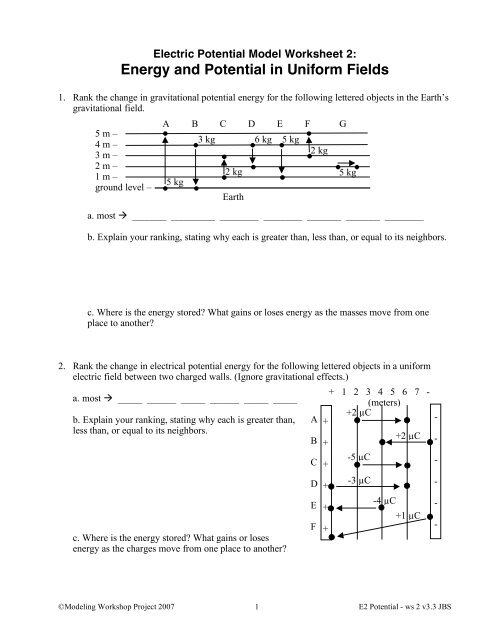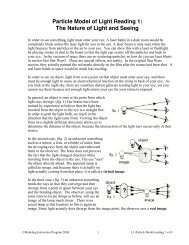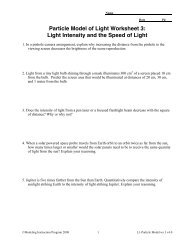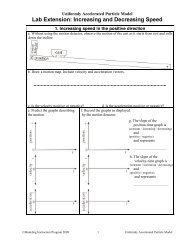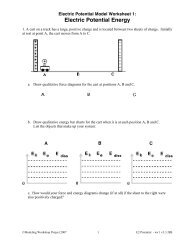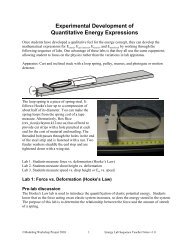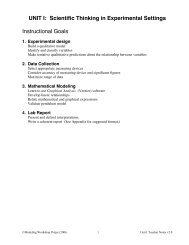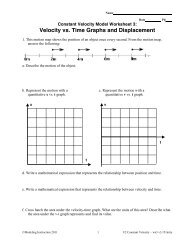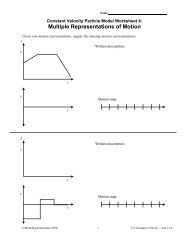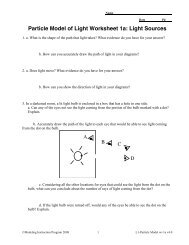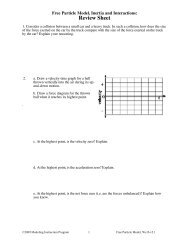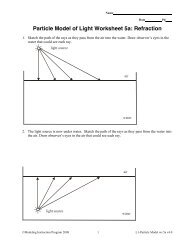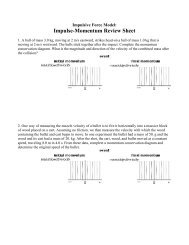Energy and Potential in Uniform Fields - Modeling Physics
Energy and Potential in Uniform Fields - Modeling Physics
Energy and Potential in Uniform Fields - Modeling Physics
You also want an ePaper? Increase the reach of your titles
YUMPU automatically turns print PDFs into web optimized ePapers that Google loves.
Electric <strong>Potential</strong> Model Worksheet 2:<br />
<strong>Energy</strong> <strong>and</strong> <strong>Potential</strong> <strong>in</strong> <strong>Uniform</strong> <strong>Fields</strong><br />
1. Rank the change <strong>in</strong> gravitational potential energy for the follow<strong>in</strong>g lettered objects <strong>in</strong> the Earth’s<br />
gravitational field.<br />
5 m –<br />
4 m –<br />
3 m –<br />
2 m –<br />
1 m –<br />
ground level –<br />
A B C D E F G<br />
5 kg<br />
3 kg<br />
2 kg<br />
Earth<br />
6 kg<br />
a. most _______ _________ ________ ________ _______ _______ ________<br />
b. Expla<strong>in</strong> your rank<strong>in</strong>g, stat<strong>in</strong>g why each is greater than, less than, or equal to its neighbors.<br />
5 kg<br />
2 kg<br />
5 kg<br />
c. Where is the energy stored What ga<strong>in</strong>s or loses energy as the masses move from one<br />
place to another<br />
2. Rank the change <strong>in</strong> electrical potential energy for the follow<strong>in</strong>g lettered objects <strong>in</strong> a uniform<br />
electric field between two charged walls. (Ignore gravitational effects.)<br />
a. most _____ ______ _____ ______ _____ _____<br />
b. Expla<strong>in</strong> your rank<strong>in</strong>g, stat<strong>in</strong>g why each is greater than,<br />
less than, or equal to its neighbors.<br />
c. Where is the energy stored What ga<strong>in</strong>s or loses<br />
energy as the charges move from one place to another<br />
+ 1 2 3 4 5 6 7 -<br />
(meters)<br />
+2 µC<br />
A +<br />
B<br />
C<br />
D<br />
E<br />
F<br />
+<br />
+<br />
+<br />
+<br />
+<br />
-5 µC<br />
-3 µC<br />
-4 µC<br />
+2 µC<br />
+1 µC<br />
-<br />
-<br />
-<br />
-<br />
-<br />
-<br />
©Model<strong>in</strong>g Workshop Project 2007 1 E2 <strong>Potential</strong> - ws 2 v3.3 JBS
3. Two books, <strong>in</strong>itially on the floor, are picked up <strong>and</strong> placed on a shelf 2.0 m off the floor. One,<br />
Twenty Other Th<strong>in</strong>gs I Like To Do With That Stuff Between My Toes, has a mass of 1.0 kg. The<br />
other, Why <strong>Physics</strong> Rules The Universe, has a mass of 2.0 kg. The gravitational field strength<br />
near the surface of the Earth is approximately 10 N/kg.<br />
a. Calculate the gravitational force act<strong>in</strong>g on each book as it rests on the shelf. What factors<br />
determ<strong>in</strong>e the size of this force<br />
b. Calculate the change <strong>in</strong> the system’s gravitational potential energy as a result of pick<strong>in</strong>g each<br />
book up off the floor <strong>and</strong> plac<strong>in</strong>g it on the shelf. What factors determ<strong>in</strong>e the size of this<br />
change<br />
c. What is the difference <strong>in</strong> gravitational potential (potential energy per unit mass) between the<br />
floor <strong>and</strong> the shelf (Use data from each book to calculate this.) What factors determ<strong>in</strong>e the<br />
size of this difference<br />
d. How does gravitational potential differ from gravitational potential energy<br />
©Model<strong>in</strong>g Workshop Project 2007 2 E2 <strong>Potential</strong> - ws 2 v3.3 JBS
4. Below are two parallel conduct<strong>in</strong>g plates, each carry<strong>in</strong>g an equal quantity of excess charge of<br />
opposite type. The plates are separated by 2.0 m.<br />
(+)<br />
(-)<br />
1 µC 2 µC<br />
2.0 m<br />
Between the pair of plates are two positively charged<br />
objects; the object on the left carries 1.0 µC of excess<br />
charge, the object on the right carries 2.0 µC. The<br />
electric field strength between the plates is uniform, <strong>and</strong><br />
approximately 10 N/C. You move each charge from<br />
the negative plate to the positive plate. [For this<br />
example, neglect the effects of the gravitational field.]<br />
a. Calculate the electrical force act<strong>in</strong>g on each object when it is between the plates. What<br />
factors determ<strong>in</strong>e the size of this force<br />
b. Calculate the change <strong>in</strong> the system’s electrical potential energy as a result of mov<strong>in</strong>g each<br />
charge from the negative plate to the positive plate. What factors determ<strong>in</strong>e the size of this<br />
change<br />
c. What is the difference <strong>in</strong> electric potential (potential energy per unit charge) between each of<br />
pairs of plates What factors determ<strong>in</strong>e the size of this difference<br />
d. What is the difference <strong>in</strong> electric potential between the negative plate <strong>and</strong> a po<strong>in</strong>t midway<br />
between the plates<br />
e. How does electrical potential differ from electric potential energy<br />
©Model<strong>in</strong>g Workshop Project 2007 3 E2 <strong>Potential</strong> - ws 2 v3.3 JBS
5. Rank the electrical potential difference for the follow<strong>in</strong>g lettered objects <strong>in</strong> a uniform electric<br />
field of 6 N/C between two charged walls. (Ignore gravitational effects.)<br />
a. most ________ _________ ________ _________ _________ _________<br />
b. Expla<strong>in</strong> your rank<strong>in</strong>g, stat<strong>in</strong>g why each is greater<br />
+ 1 2 3 4 5 6 7 -<br />
than, less than, or equal to its neighbors.<br />
(meters)<br />
+2 µC<br />
A +<br />
-<br />
be given <strong>in</strong> V m . Show that these units are equivalent. B +<br />
+2 µC -<br />
C +<br />
D +<br />
-5 µC<br />
-3 µC<br />
-<br />
-<br />
E<br />
-4 µC<br />
+<br />
-<br />
+1 µC<br />
F +<br />
-<br />
6. Rank the electrical potential at the positions of the lettered charges <strong>in</strong> a uniform electric field of<br />
10 N/C between two charged walls. The negative wall potential has arbitrarily been designated<br />
as 0 Volts.<br />
a. most ________ _________ ________ _________ _________ _________<br />
+ 1 2 3 4 5 6 7 -<br />
b. Expla<strong>in</strong> your rank<strong>in</strong>g, stat<strong>in</strong>g why each is greater than,<br />
(meters) 0 V<br />
less than, or equal to its neighbors.<br />
+2 µC<br />
A +<br />
-<br />
B +<br />
+2 µC -<br />
C +<br />
-5 µC<br />
-<br />
D -3 µC<br />
+<br />
E +<br />
F +<br />
-4 µC<br />
+1 µC<br />
-<br />
-<br />
-<br />
7. The units for electric field were given as N . It turns out that the electric field strength can also<br />
C<br />
©Model<strong>in</strong>g Workshop Project 2007 4 E2 <strong>Potential</strong> - ws 2 v3.3 JBS


